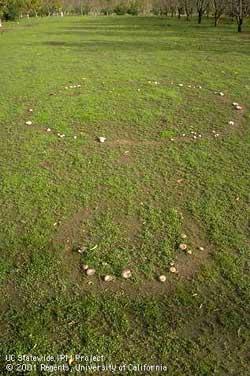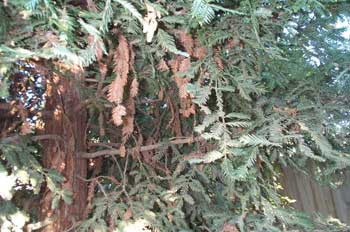
July
Lawn Grubs
Q. There are irregularly-shaped dead patches in my lawn and birds and squirrels are digging in the patches. What is killing the lawn and what are the birds and squirrels looking for?
A. While lawn insects are not usually a serious problem in our area, it is possible that the white grubs or the larval stage of several insects including rose chafer and June beetles may be feeding on the grass roots. Try to lift up a foot square area of grass to check underneath for grubs. If the dead grass won't lift, the problem probably isn't grubs. The drench test is also an effective means to check for other lawn insects such as billbugs. Mix 2-4 tbs. of liquid dishwashing soap (1 1/2 tbs. of an Ultra product) with 1 gallon of water. Apply evenly to a 2 yard square area on the lawn, including the dead patches. During the next 10 minutes, count (and try to identify) the insects which will rise to the surface. If there are 6 or fewer grubs or insects per square foot, the problem isn't severe, the insects can be controlled with improved cultural practices and the lawn can be reseeded.
If there are more than 6 grubs per square foot, treat the grass with Bt (Bacillus thuringiensis), neem or with beneficial nematodes.
Pest Note: Masked Chafer (White grubs)
Lawn Fungi
Q. Large, irregular, circular dead spots are appearing on my lawn. It was lush and bright green a week or two ago and now looks shabby. What's causing these spots?

Remove thatch by raking out the dead, matted grass blades, aerate the soil using an aerator attachment on a tiller or mower (or by wearing golf or spike shoes when working on the lawn), cut down on high nitrogen fertilizer and water deeply and infrequently to encourage deep root development. Raise the mower level so that only 1/3 of the grass height is cut a one time. This both helps shade the grass roots and leaves more grass blade surface area to handle fungal spores.
Pest Notes: Lawn Fungi
Whiteflies
Q. The leaves on some of my plants are turning up and looking sickly and there is sticky stuff on them. When I tap the plant, tiny white insects fly up. What are they and are they a serious problem?
A. These are whiteflies, tiny sap-sucking insects that are found on many types of plants. Whiteflies have many natural enemies, including lacewings and parasitic wasps. Since the release several years ago of whitefly enemy parasitic wasps here in the San Joaquin Valley, whiteflies have been less of a problem although populations fluctuate yearly. Because beneficial insects can control the whitefly population, chemical pesticides should not be used on infested plants. Instead, try vacuuming the flying adults in the early morning or spray insecticidal soap, making sure to cover undersides of all infested leaves. Spray when temps are cool to avoid damage to the plants. Sticky yellow traps which will attract whiteflies can be purchased or made using yellow paper covered with one part petroleum jelly and one part household detergent. The homemade formula has the advantage of being easily washed off and the stickiness returns. Whiteflies don't fly far, so many traps may be needed. Control for ants that are attracted to the honeydew are recommended. Use non-toxic sticky barriers or boric acid baits to control ants.
Pest Notes: Giant Whiteflies
Quick Tip: Giant Whitefly
Quick Tip: Whiteflies
Redwood Summer Dieback
Q. The needles on my redwood tree are turn from green to yellow to brown and then dropping off. A lot of twigs are also falling off. It gets regular irrigation, but does it need more water or what?

Redwood trees need to be spaced at least 7 feet apart and will require regular summer watering and occasional feed for the first 5 years.
Eucalyptus Redgum Lerp Psyllid
Q. I live in the foothills and my long driveway is lined with about 75 eucalyptus trees. This year the trees are dripping sticky stuff and the leaves are covered with black soot. Some sort of small white, encrusted thing is on the back of the leaves. The trees are beginning to lose most of their leaves as well.
Q The tree expert says that it is a scale-type insect and he wants to inject each tree with a systemic chemical to kill the insects. At a cost of $65.00 per tree, this is going to be very expensive. Is he right? Is this treatment effective and worth the cost?
A. The tree expert has correctly identified the Eucalyptus Redgum Lerp Psyllid (RGLP for short) which is now serously infesting many eucalyptus trees in California. RGLP are plant-juice sucking insects which, during their nymph or larval stage have a hard covering or cap of crystallized honeydew as a protective covering. The RGLP are stationary at this stage.
High populations of RGLP secrete copious amounts of messy, sticky honeydew and a backish sooty mold grows on honeydew-covered surfaces. This is annoying to people, but doesn't have a serious adverse affect on the trees health. However, extensive defoliation weakens trees and increases tree susceptibility to other wood-boring insect pests. Most trees can withstand several defoliations before dying.
Predatory wasps which are the natural enemy of RGLP in Australia have been introduced to California with the hope that they will control the RGLP population. Results of this introduction have been slower than expected.
Cultural control includes minimizing tree stress with proper care. Provide supplemental water during periods of prolonged drought, at least once a month. Irrigate infrequently at the outer edge of the canopy, not near the trunk, so that the water penetrates deeply (at least 3 feet) into the soil. Avoid fertilization which encourages the growth of succulent new green growth that RGLP just love to feed on. Prune lightly in winter when the trees are semi-dormant.
Pesticide effectiveness against the RGLP is not known. Sprays do not penetrate the psyllida's hard shell (lerp) and they are impractical for use on tall trees because of spray drift that cannot be controlled.
Certain systemic insecticides may control RGLP, but this has not been veritifed. The holes drilled into the trunks or roots to implant the insecticide plugs causes undesirable wounds that can serve as entry points for plant pathogens. Avoid injecting trees more than once a year.
Imidacloprid (Merit "! ) can be used as a soil drench beneath trees. This application method avoids wounding the weakened tree and may be effective if applied to soil during late winter to early spring. It can take several months for the chemical to transport out to the leaf canopy and control the RGLP.
Make sure that any chemical control is performed by a licensed pest control applicator.
Pest Note: Red Gum Eucalyptus Lerp Psyllid
Information on the Master Gardener Program
Q. How do I become a Master Gardener? What are the schedule, the process, the requirements, and the application deadline?
A. Click here to learn about Master Gardeners.
